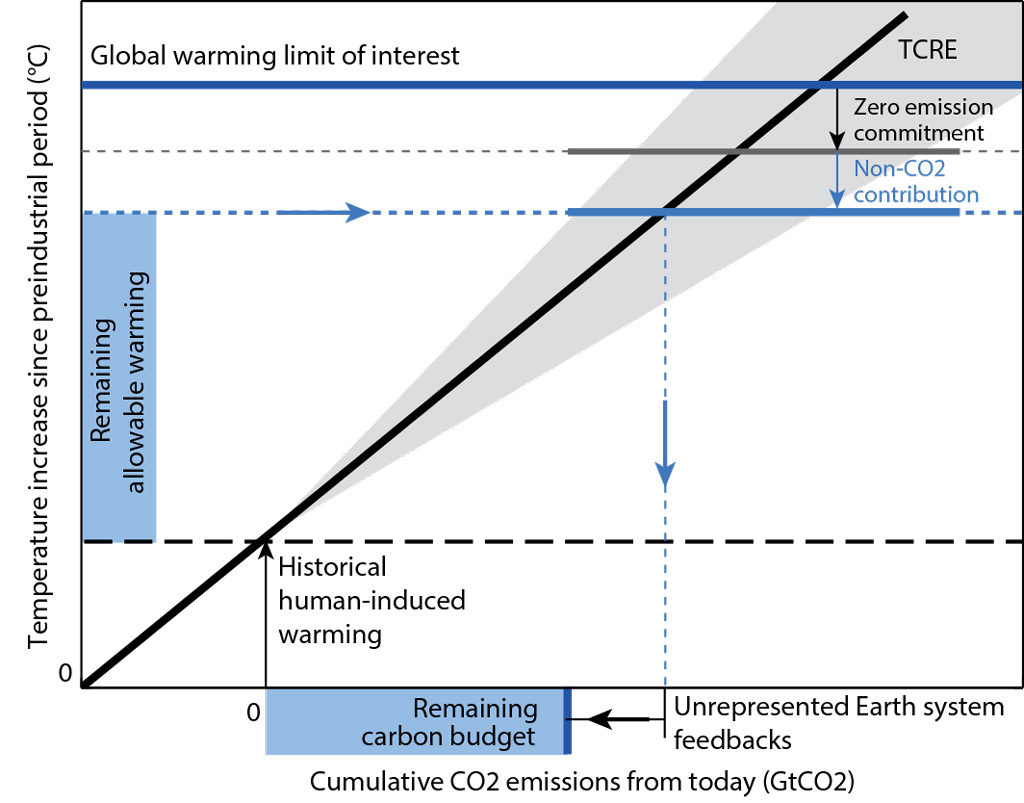
Guest post: A new approach for understanding the remaining carbon budget
Multiple Authors
07.17.19Multiple Authors
17.07.2019 | 6:00pmDr Joeri Rogelj is a lecturer in climate change and the environment at the Grantham Institute at Imperial College London, and Prof Piers Forster is professor of climate physics at the University of Leeds and founding director of the Priestley International Centre for Climate.
The concept of a “carbon budget” has proved to be both elegantly simple and stubbornly complicated.
The theory dictates that the total amount of CO2 emitted until emissions are taken down to zero determines the maximum warming that the world will subsequently experience. This was the promise from a series of seminal studies published nearly a decade ago.
Our latest understanding of climate science teaches us that this promise is still largely kept, but it turns out things are not quite so straightforward when estimating how much carbon budget remains if we want to cap warming to a precise level. The estimated size of the remaining carbon budget can depend on a whole range of factors, which makes it much trickier to compare different estimates directly.
As authors on the Intergovernmental Panel on Climate Change’s special report on 1.5C of global warming (SR15), part of our task was to bring the different carbon budget estimates together.
In our new study, published in Nature, we now show how the estimates from early carbon budget studies can be reconciled – and how carbon budget nuances can be understood to inform the climate action required by the Paris Agreement.
Remaining emissions
Published in 2013-14, the fifth assessment report (AR5) of the Intergovernmental Panel on Climate Change (IPCC) established that there is a linear relationship between the total amount of CO2 we put into the atmosphere and the amount of global warming.
This led directly to the concept of a carbon budget – the total amount of cumulative CO2 emissions allowable in order to stay under a given global warming level.
As the Paris Agreement has the goal to keep warming well-below 2C and preferably 1.5C, the trillion-dollar question thus became: How much of a carbon budget do we have left?
This is an important question. Knowing how much remaining carbon budget is left allows us to define mitigation pathways towards achieving the Paris temperature goal. It also allows scientists to inform the adequacy of global net-zero goals.
Thus, the quest was on to quantify such remaining carbon budgets. Many researchers took up the challenge to produce new, updated and more nuanced estimates of the remaining carbon budget.
Despite these good intentions, the large and unexplained variations between the different estimates left analysts confused. There was limited understanding of the reasons behind these numbers which resulted in some unhelpful confusion amongst science commentators.
Clearing up contributions
This confusion was the starting point for the author team of the IPCC’s SR15. Our task was to carry out an assessment of the remaining carbon budget in line with limiting warming to 1.5C.
So we began by analysing all factors that could possibly affect calculations of the size of the 1.5C carbon budget. Helped by the expert feedback during the various IPCC review rounds the remaining carbon-budget puzzle was, ultimately, reduced to variations in a set of five main factors that together explain the estimated size of the remaining carbon budget for a specific temperature goal:
- The estimate of global warming up to the present day;
- The assumed future warming from emissions of non-CO2 forcings such as methane and black carbon and the reduction of cooling sulphate emissions;
- The amount of warming still in the pipeline once emissions are brought back to zero;
- The ratio between cumulative CO2 emissions and global warming (also known as the transient climate response to cumulative carbon emissions, or “TCRE”); and
- The extra emissions from Earth system processes or feedbacks that are typically not included in the models used to make these estimates, such as thawing permafrost.
These insights have now been structured and published in our paper, and the interplay between these five factors is shown in the figure below.
It takes a little explaining. Along the x-axis is the cumulative CO2 emissions from today; along the y-axis is the temperature increase since pre-industrial times. The dashed lines show the different factors that can affect the total budget – such as the estimate of historical warming and the contribution of non-CO2 emissions. And then joining it all together is the estimate of TCRE – the diagonal bold black line, with the uncertainty range shaded grey.

Schematic showing how the remaining carbon budget can be estimated from various independent quantities, including the historical human-induced warming, the zero emission commitment, the contribution of future non-CO2 warming, the transient climate response to cumulative emissions of carbon (TCRE), and further correcting for unrepresented Earth system feedbacks. Source: Rogelj et al. (2019)
Our chapter in the IPCC SR15 applied a version of this framework to assess the remaining carbon budget to keep warming to 1.5C. So let us use it here as an illustration of how these various factors fit together.
We used an estimate of 0.97C of warming for the 2006-15 period since pre-industrial times, an estimated additional non-CO2 warming of about 0.1C, and a TCRE range from the AR5 of 0.8-2.5C per 1,000 gigatonnes of carbon (equivalent to 3,664Gt of CO2).
The zero-emissions commitment was assessed to be around zero for warming of 1.5C by a different chapter of the report – and the estimated total remaining allowable warming was, thus, of the order of 0.4C.
Finally, Earth system processes that are typically not included in models were assessed to be roughly of the effect of 100 GtCO2 additional emissions over this century, but would increase further over the following centuries.
Putting all these factors together and taking into account emissions since 2011 then results in a remaining carbon budget from 2018 onwards of 580GtCO2 for a 50% chance of keeping warming below 1.5C. This is less than 15 years of global emissions at current rates.
So, what does that mean?
This means that if we start reducing emissions steeply now and by the time we reach net-zero levels we have not emitted more than 580GtCO2, our best scientific understanding tells us have we expect a one-in-two chance that warming would be kept to 1.5C.
Moreover, if we want to be sure that this is also true until the end of the century, we’d have to aim to emit only 480GtCO2 until we reach net-zero instead. This is under 12 years of current emissions.
Our best scientific understanding will, of course, improve with time and this number will, thus, be adjusted either up or down. If a current 50% chance of avoiding 1.5C is not enough, the budget you aim for should be smaller. And if you want to avoid the risk of a downward adjustment putting a particular climate target beyond reach, then you should start aiming for a smaller budget now.
The variations around this number are now much better understood and quantified, and an overview of these can be found in chapter two of SR15.
Whence the confusion?
Now that we understand why estimates of remaining carbon budgets can differ, some of the confusing variations between earlier published carbon budget estimates can also be explained.
First of all, carbon budgets estimates starting from pre-industrial times are more likely to vary than those calculated from the present day. The main reason for this is that uncertainties and errors accumulate over the several centuries that are modelled in the lead-up to today. As a result, these studies are using starting points that are already less precise.
When expressing remaining carbon budgets relative to a more recent reference period that is informed by observations, the variation between estimates is already strongly reduced but not entirely eliminated.
An additional source of carbon-budget variations is the method that is used to estimate global warming. Different methods of calculating global temperatures are used by different scientific groups in the US, UK and Japan, for example. And each group uses slightly different approaches for how they treat issues such as changes in the way measurements have been taken over the decades and a lack of observed data over the Arctic. Also, analysis of climate change projections with climate models can also use yet another slightly different method.
These differences are really nothing more than a labelling issue. However, when inappropriately mixed up, they result in arbitrary changes in reported remaining carbon budgets that, ultimately, can result in pursuing weaker climate targets than the well-below 2C and 1.5C limits set in the Paris Agreement.
Next, the contribution of future warming due to factors other than CO2 is difficult to assess if this information is not explicitly provided by the underlying studies. Hence, we call to make this information available when publishing new estimates of remaining carbon budgets.
But it is worth noting that studies that provide estimates with and without particular additional Earth system feedbacks, such as permafrost thawing, do tend to show that the inclusion of such feedback consistently results in smaller remaining carbon budgets.
A final source of confusion is when numbers are compared that have little relationship to each other. This is the case when studies report cumulative CO2 emissions from scenarios – for example, from 2016 to 2100. Such numbers have little relationship with the physical definition of carbon budgets as discussed here, although at times they have been mistaken for carbon budgets.
In our paper, we provide an overview of the various ways in which carbon budgets can be presented in scientific literature. And we have made available online an accompanying checklist of key information (in the supplementary information of our paper) that future studies should provide so that their estimates can be adequately put into context.
Communicating the future
Carbon budgets have been proven to be a robust concept to characterise the climate change mitigation challenge. They also provide the scientific underpinning for net-zero targets and their implied adequacy of limiting warming to acceptable levels. However, communication around them can still vastly improve.
Our new framework allows us to clearly understand and explain how scientific improvements result in updated estimates of the remaining carbon budget.
Science communicators and analysts can then use this information both to track changes in estimates of the remaining carbon budget over time and to inform their expert judgment about how plausible or reliable updated estimates are.
Rogelj, J., Forster, P. M., Kriegler, E., Smith, C. J. and Séférian, R. (2019) A framework to estimate and track remaining carbon budgets for stringent climate targets, Nature, doi:10.1038/s41586-019-1368-z [the full paper is free to access at this link]
-
Guest post: A new approach for understanding the remaining carbon budget
-
Comparing carbon budgets for the IPCC 1.5C special report

